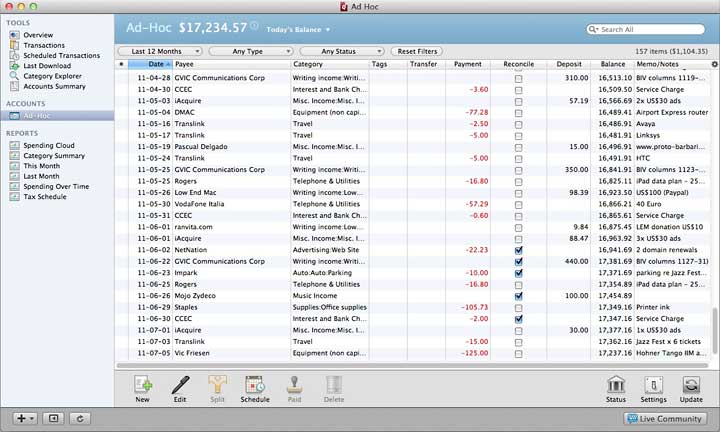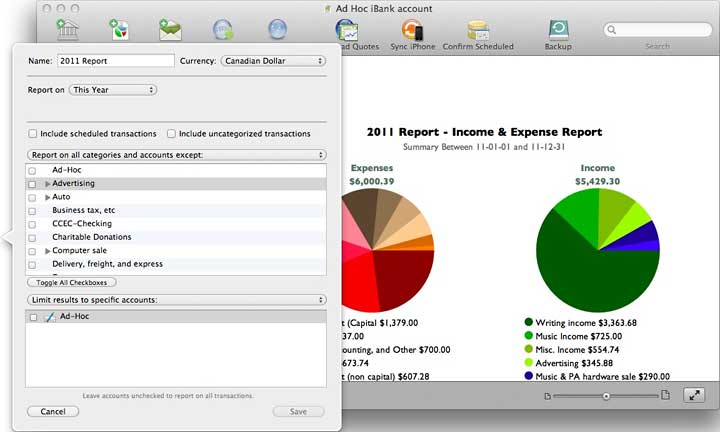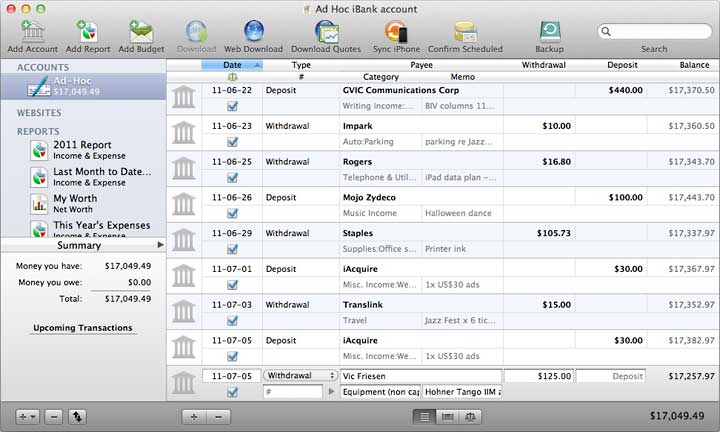
|
iBank a Better Choice for Mac Quicken Users Moving to
Lion
by Alan Zisman (c) 2011
First
published in Low End Mac
August 12, 2011
In July, I wrote in Using Quicken for Mac? Read This Before You Upgrade to
Lion about issues that I - along with any Mac user running an older
copy of Intuit's Quicken personal finance software - would be having
when upgrading to OS X 10.7 Lion.
Migrating to Quicken
Essentials
Briefly, Lion no longer includes Rosetta, Apple's software that, in
previous versions of OS X, allowed Intel Macs to run software created
for earlier PowerPC Macs. Although all Macs have used Intel CPUs since
2006, Intuit coded all Mac versions of Quicken prior to the current
Quicken Essentials 2010 for PowerPC. Moreover, the Quicken File
Exchange utility included with the current version of Quicken - used to
import data from earlier versions or Windows versions - is also
compiled for PowerPC Macs. As a result, Quicken 2005 (which I was
running), Quicken 2007, and the Quicken File Exchange utility won't run
on a Mac running Lion.
Intuit has not been especially helpful to its Mac user base; the
company's advice to users with this problem is to open an account with
Intuit's Mint.com online financial service. The problem: It doesn't
import existing financial data. Otherwise, Intuit suggests users
install Windows on their Mac (perhaps using one of several
virtualization programs) and run the Windows version of Quicken.
Intuit does have a Mac product, Quicken Essentials 2010, which will run
under Lion - and which will import Quicken 2007 exported data, as long
as the data is imported into Quicken Essentials prior to installing Lion (since, as
I mentioned above, the Quicken File Exchange utility requires Rosetta,
and hence won't run under Lion).
In the July article, I walked users through the process I went through
of exporting and importing my Quicken data - something that I did prior
to upgrading to Lion.
Disenchanted with Quicken
Essentials
Although I was able to successfully import my financial data into
Quicken Essentials, I quickly became disenchanted with the program.
My needs in financial software are fairly basic. I need something that
lets me enter expenses and income, keeping a balance, and assigning
each item into a category. Quicken Essential does this fine.

But I also need to be able to create a report for each year, showing my
expenses and income by category, and totaling each category. This is
helpful when filing my income tax return.
And unlike the 2005 version of Quicken I was previously using, Quicken
Essentials 2010 doesn't let me do that. It has a menu item labeled
Export Tax Report - but that creates a report that can be used only by
Intuit's companion TurboTax software, and only in the US. (I'm in
Canada.)
I could, I discovered, display just the current year's transactions,
then export to CSV (Comma Separated Values) format, a standard text
file format that can be imported into a spreadsheet like Microsoft
Excel. In Excel, I could sort the data by category, then manually total
up each category, and eventually end up with something approximating
the reports that I could quickly create in the earlier version. But
that's a lot of effort.
(It's not like this is a particularly advanced requirement. Prior to
using Quicken 2005, I was a running the 3.0 version of Microsoft Money,
a piece of Windows software so old that it shipped on a single floppy
diskette.)
Update - I was wrong
about Quicken Essentials' lack of reports - a reader pointed out to me
that while what I wanted isn't available from the Reports menu item
(Why not, Intuit?) it is in
fact listed - in plain view - as an option in the main window. Look at
the image above - there's a section labelled Reports. And there, for anyone (but
obviously, not for me!) to see, is Category
Summary - just what I was looking for. I'm still not happy with
Quicken Essentials' clumsy, multi-stage way of importing my data from
my old version, as described in my earlier article, but it can do the report that I needed.
Luckily, Quicken Essentials 2010 ($50) is not the only option for Lion
users.
iBank
Another alternative is iBank. This $60 program (also available through the Mac App Store, free trial
version available from company website) is far more capable than
Quicken Essentials; like older versions of Quicken (and current Windows
Quicken versions), it does far more than I need, promising the ability
to manage a variety of account types, track loan interest and payment
schedules, manage multiple accounts, download transactions directly
from many financial institutions, track investments, and much, much
more.
While I don't need most of those features, it also allows report
creation - from simple reports (like I need) on up.

And it imports Quicken QIF exported data files. And,unlike Quicken
Essentials, it can do so while running on Lion. I was able to import
the same data file that I'd previously used with Quicken Essentials.

There's even an iBank Mobile iOS app ($5) that syncs with the Mac
version over WiFi.
One oddity: With the same old Quicken data imported into both Quicken
Essentials and iBank, the two applications show different totals - a
difference of about $20. That puzzles me, but I'm prepared to live with
it.
In any event, even with what I think are fairly minimalist needs, I'm
finding iBank much more usable as a Quicken replacement than Intuit's
anemic Quicken "Essentials".
But even though iBank can import older Quicken data while running in
Lion, Mac users of an older Quicken version still need to remember to
export the data from Quicken prior to installing Lion. After upgrading
to Lion is too late!
|

